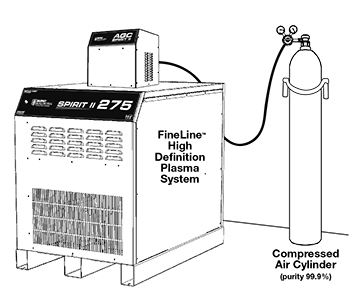Don't Overlook Clean Air For Plasma Cutting
With the recent advancements in plasma cutting technology and torch design, fabricators are now able to cut parts with unprecedented precision. For instance, the Spirit® II FineLine™ can achieve edge angularity of two degrees or less with virtually no dross build-up. The benefits of such a system are less post-process work and reduced labor costs. However, there are several factors that can reduce the effectiveness of such an advanced plasma cutting system. One of the easiest to overlook is compressed air quality.
Typical shop compressors convert shop atmospheric air to pressures upwards of 130 psi, which is then supplied to the plasma system through a series of metal piping or hoses. The pressurized air cools naturally on its way to the plasma torch, resulting in moisture contamination. Most compressor holding tanks have a release valve that can be activated to purge water buildup, but additional filtration is required to completely remove all remaining moisture in the transport lines.
In addition to moisture buildup, most compressors that are motor-driven have a tendency to contaminate the air with lubricating oil. Standard particulate filters may catch the liquid oil in the lines, but additional specialized filters should be added to prevent any remaining oil aerosols from reaching the torch. Using compressed air without the right filtration can result in reduced cut quality, or even catastrophic torch failure.
The best way to prevent contaminated air and ensure the absolute best cut quality is to use compressed cylinders of air with a purity of 99.9%; however, if shop air is used, it must be cleaned to ISO 8573.1 Class 1.4.1 Standards. This can be achieved by using filter types AO, AA, and ACS in conjunction with a water separator and dryer. Below are diagrams of each of these methods. The equipment shown is only representational and is not meant to specify any manufacturer.

Preferred Method

Acceptable Method
Grade AO – High Efficiency General Purpose Protection
Used for the removal of particles down to 1 micron including water and oil aerosols, providing a maximum remaining oil aerosol content of 0.6 mg/m3 @ 21 °C.
Grade AA – High Efficiency Oil Removal Filtration
Used for the removal of particles down to 0.01 micron including water and oil aerosols, providing a maximum remaining oil aerosol content of 0.01 mg/m3 @ 21°C.
Grade ACS – Activated Carbon Filtration
Used for the removal of oil vapor and hydrocarbon odors providing a maximum remaining oil vapor content of 0.003 mg/m3 (excluding methane) @ 21°C.
